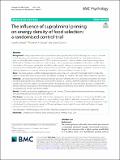The influence of supraliminal priming on energy density of food selection : a randomised controlled trial
Abstract
Background: Many people exercise because they know it is good for their health. Although this is true, it can make us feel deserving of a reward and lead us to eat more indulgent, less healthy food than if we had not done any exercise. Generally, lower energy-dense (LED) foods are recognised as healthier choices than higher energy-dense (HED) options. Despite our intention to make healthy choices, seeing tempting higher-calorie foods on offer often side-tracks us. Priming is a psychological tool that makes specific changes to our environment that remind us of our motivation to be healthy. This makes it easier to choose a healthier option, by nudging us towards it without us even realising. However, it is currently unclear which method of priming achieves the best results. Aims: Our study explores whether priming people to expect they will receive LED food leads them to make this healthier choice after exercise, even when also offered tempting less healthy HED foods at the moment of selection. Methods: Our study observed the foods selected by university athletes after their sports matches. Before the match, half of the participants were primed by asking them to choose a LED snack from the options we offered, which they would receive after the match. The remaining half of participants were not asked this same question. To distract the athletes from our observation of their food choices, participants completed a task prior to choosing their snack, which was disguised as a ‘thank you’ for taking part. Results: Overall, we found the priming group did not choose LED foods significantly more than the control group, hence priming did not increase LED food selection. Conclusion: Importantly, our results indicate that priming must be more noticeable to achieve its goal. Additionally, we demonstrated that priming may be less successful for young athletic individuals, compared to older and more overweight adults recruited in other studies. This highlights the importance of studying a broader demographic range of individuals from the general population. We support future research into this area, which will help us to tweak priming to achieve the best outcomes.
Citation
Schlegel , I , Ozakinci , G & Carstairs , S A 2021 , ' The influence of supraliminal priming on energy density of food selection : a randomised controlled trial ' , BMC Psychology , vol. 9 , 48 . https://doi.org/10.1186/s40359-021-00554-1
Publication
BMC Psychology
Status
Peer reviewed
ISSN
2050-7283Type
Journal article
Description
Funding: This research was funded by the University of St Andrews and did not receive any specific grant from funding agencies in the public, commercial or not-for-profit sectors.Collections
Items in the St Andrews Research Repository are protected by copyright, with all rights reserved, unless otherwise indicated.

